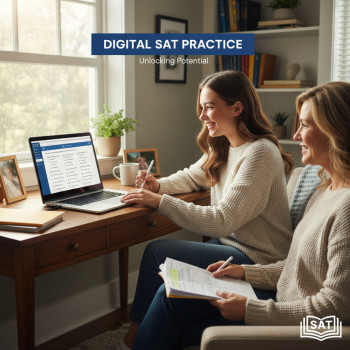Introduction: You Can Prep for the Digital SAT and Still Have a Life
If you’re reading this, you probably care about doing well on the Digital SAT — but you also want to keep friends, hobbies, and sanity intact. Good news: those things aren’t mutually exclusive. The myth that high scores require a hermit-like existence is not only outdated, it’s unhelpful. What you need is a realistic plan, a few science-backed habits, and the confidence to say “yes” to balance.
Why this matters
The SAT is a snapshot—important, yes, but not a full portrait of who you are. How you prepare for it can shape your mental health, your relationships, and your motivation. Prepare smart, not hard: build momentum with consistent study blocks, keep your social life to refill your emotional tank, and use targeted help where it matters most. That balance is what helps you show up focused and calm on test day.
Step 1: Make a Purposeful, Flexible Plan
Planning feels boring, but it’s the single best way to protect both your prep and your free time. A clear plan converts vague anxiety into specific actions — and gives you permission to relax when you’re off the clock.
Start with the end in mind
Ask three quick questions: When is your test date? What score do you want? How much time can you realistically dedicate weekly without burning out? With answers to those, you can build a plan that’s ambitious and humane.
Use time-blocking, not marathon sessions
Block out weekly study windows the same way you’d block a class or a shift at work. Shorter, focused sessions beat long, unfocused marathons. Consider these patterns:
- 3–5 focused sessions of 45–60 minutes each per week for content review.
- 1 full-length practice test every 1–2 weeks (use the Bluebook practice tests to simulate the digital environment).
- 2 short sessions (20–30 minutes) for targeted drills, vocabulary, or mistakes review.
By putting sessions on a calendar you also create visible boundaries: friends see you’re busy during those blocks, and you’re more likely to honor the time yourself.
Step 2: Build a Study Rhythm That Fits Your Life
Instead of trying to cram everything into late nights and marathon weekends, design a rhythm that supports sustained progress. The goal is consistency — not intensity.
Weekly blueprint (example)
| Day | Activity | Duration | Why it works |
|---|---|---|---|
| Monday | Math practice (problem sets + review) | 60 minutes | Strong start to the week keeps momentum |
| Tuesday | Short reading/drill (timed) | 30 minutes | Builds stamina without overload |
| Wednesday | Rest or social activity | — | Prevents burnout; social time = recharge |
| Thursday | Writing & grammar practice | 45–60 minutes | Focus on weak spots |
| Friday | Mixed drills + review mistakes | 45 minutes | Consolidates learning |
| Saturday | Full-length practice test (Bluebook) | 3–4 hours | Simulates test day and tracks progress |
| Sunday | Light review + social time | 30 minutes + rest | Reflection and recharge |
This blueprint is just an example. The important part is to protect a weekly social/rest day and to vary intensity so you don’t peak too early or crash.
Step 3: Make Social Life Part of the Prep Plan
Instead of viewing social time as “time lost,” treat it as fuel. Good friends, family dinners, practices, and hobbies help memory consolidation, reduce stress, and keep your motivation genuine.
Study with friends—intentionally
Group study can go wrong fast: it’s easy to socialize and not study. Use structure to keep it productive:
- Set a short shared agenda (e.g., 30 minutes of vocabulary drills, 45 minutes solving a practice section).
- Rotate roles: timer, problem-explainer, note-taker.
- End with a 20–30 minute social break — a reward for staying focused.
Smart social choices
Not all social time is equal. Choose activities that restore energy rather than drain it. Low-key hangouts, outdoor walks, or creative hobbies often recharge better than late-night parties before a practice test.
Step 4: Use High-Impact, Low-Time Strategies
As the Digital SAT shifts toward shorter, adaptive testing, efficiency matters. Small, smart habits produce big results.
Target weaknesses, not everything
A lot of students study broadly because it feels safer. Instead, use a practice test to identify 2–3 weak areas and prioritize them for a few weeks. This targeted approach reduces study time and improves scores faster.
Active review beats passive reading
Practice problems, flashcards, and explaining answers out loud help you remember more than rereading notes. After a question, always ask: why is the right answer right, and why are the wrong answers tempting?
Leverage technology wisely
Official digital practice tests (like those available in the Bluebook testing app) give you realistic experience with the testing interface. Combine that with focused drills on a platform that tracks performance — this reduces wasted hours and builds adaptive test confidence.
Step 5: Protect Your Mental Health
Test prep isn’t just intellectual — it’s emotional. Anxiety and guilt are normal, but you can manage them.
Give yourself permission to be human
If you miss a study block because you needed time with friends, that’s okay. Guilt is a signal, not a sentence. Reframe mistakes as data: what went wrong and how will you adjust tomorrow?
Rituals that stabilize
- Sleep routine: aim for consistent bed and wake times, especially before practice tests.
- Pre-test ritual: a 10-minute warm-up of light practice and deep breathing.
- Decompression time: 30–60 minutes after study for a hobby or a walk.
Step 6: Make Practice Tests Work for You — Not Against You
Full-length practice tests are essential, but they’re also time-consuming and emotionally intense. Use them strategically so they empower rather than exhaust.
When to take practice tests
- First baseline: take one early to identify weak areas.
- Mid-prep: take a practice test every 2–3 weeks to measure growth and adjust the plan.
- Final stretch: in the last 2–4 weeks, take one or two practice tests under test-day conditions to fine-tune endurance and timing.
How to review a practice test
Don’t just look at the score — dig into the answer choices and timing. Create a short error log with the following columns: question type, mistake cause (content, timing, careless), and one corrective action. Over time, patterns emerge more clearly than a single raw score.
Step 7: Ask for Help — The Smart Way
Knowing when to get help is maturity, not weakness. Tutors, teachers, and targeted resources compress months of wandering into weeks of progress if used well.
What to look for in targeted support
- Personalized plans that focus on your specific gaps.
- 1-on-1 guidance to explain not just what to learn, but how to think about problems.
- Tools that provide insights from practice test data so you spend time on what moves the score needle.
For many students, Sparkl’s personalized tutoring fits naturally here: expert tutors build tailored study plans, offer 1-on-1 guidance to clear sticking points, and combine human coaching with AI-driven insights to focus your practice. When a study plan aligns with your social commitments, you get progress without sacrificing life.
Step 8: Learn to Say No — Gently
Balancing prep and social life sometimes means turning down invitations. The trick is to be honest and kind about it. You don’t have to give a long explanation — a simple, “I’ve got a practice test Saturday, can we do next week?” is enough. Most friends will respect it, and scheduling social time in advance keeps relationships intact.
Two communication scripts
- Short and clear: “I can’t make it tonight — practice test tomorrow. Rain check?”
- Offer an alternative: “I’m studying tonight, but free Sunday afternoon — coffee then?”
Small Habits That Add Up
Big results come from tiny, repeatable actions. Here are simple habits to incorporate without major disruption:
- Daily 10-minute review of errors or vocabulary.
- One timed section once a week to maintain pacing.
- End-of-day reflection: what went well in study and social life?
- Celebrate small wins: a completed practice test, a stubborn concept finally clicking, or a week of steady sleep.
Plan + Flexibility: A Realistic Example
Meet Maya, a junior balancing classes, soccer practice, and college planning. She wants to reach a target score but refuses to give up nights with friends. Here’s how she does it:
- Baseline: takes one Bluebook practice test and identifies weak areas in algebra and sentence structure.
- Schedule: 4 study blocks per week of 45–60 minutes, plus a full practice test every other Saturday. Wednesday evenings are social time.
- Support: two sessions per month with a Sparkl tutor to deepen concepts and create targeted drills. Her tutor helps her focus practice so she doesn’t waste time on already-strong areas.
- Rituals: consistent bedtime, 10-minute review each night, and a short walk after long study sessions to reset her mood.
Result: steady score improvement, no major missed social events, and less burnout because Maya built flexibility into her plan.
When Things Go Off Track — Quick Recovery Strategies
Life happens. Missed a week of study because of family stuff? Don’t panic. Here’s how to get back on track without guilt:
- Reset: take a short, untimed practice section to gauge where you are.
- Trim: focus the next week on one weak area rather than trying to catch up on everything.
- Compensate with quality, not quantity: shorter, deliberate practice sessions beat frantic cramming.
Putting It All Together: A Balanced Mindset
Balancing SAT prep and social life is less about perfect symmetry and more about intention. Your plan should protect study time, but it should also protect joy. When you respect both, you study smarter and live better.
Final checklist
- I have a test date and a realistic target score.
- I created a weekly plan with at least one social/rest day.
- I take practice tests strategically and review them deeply.
- I use targeted help (tutoring or focused resources) for stubborn gaps.
- I communicate boundaries with friends and choose restorative social activities.
- I prioritize sleep, movement, and short decompressing routines.
Tools and Resources to Keep in Your Toolkit
Some tools make balance easier: a calendar (digital or paper) for blocking time, the Bluebook practice tests for realistic digital practice, focused question banks for targeted drills, and occasional tutoring for efficient progress. A well-chosen tutor can transform scattered study into a clear, efficient path to improvement—especially when they provide 1-on-1 guidance, tailored study plans, and feedback that saves you hours of aimless work.
Parting Thoughts: You’re More Than a Score
Remember: your SAT score is an important data point, not the definition of your worth. Preparing well requires discipline, but succeeding without sacrificing relationships or health requires wisdom. The best students I’ve known were the ones who paced themselves, asked for help when needed, prioritized sleep, and protected regular time with friends. Those are the students who learned how to manage stress, which is a skill that extends far beyond any test.
If you want help building a balanced, efficient plan tailored to your life, working with a tutor who understands both the Digital SAT and your schedule can be a game-changer. Thoughtful, personalized tutoring — with 1-on-1 guidance, tailored study plans, and data-driven insights — can accelerate progress while preserving the things that keep you human.
Ready to start? One small step right now
Open a calendar and block one focused study session this week — and then block one intentional social hour. That tiny act declares to yourself that both matter. Build forward from there: consistent, smart practice and intentional rest will get you farther — with less guilt — than any frantic cram.
Good luck. You’ve got this.














No Comments
Leave a comment Cancel